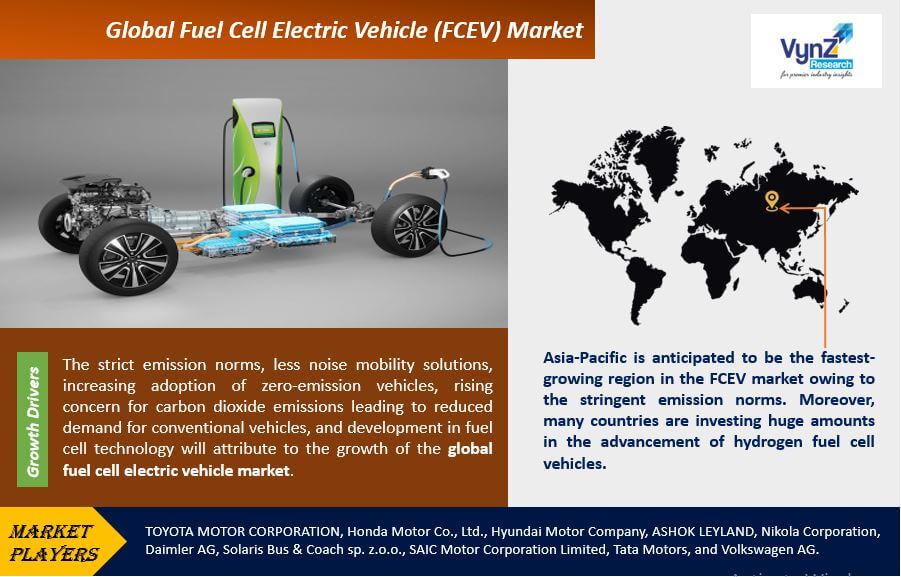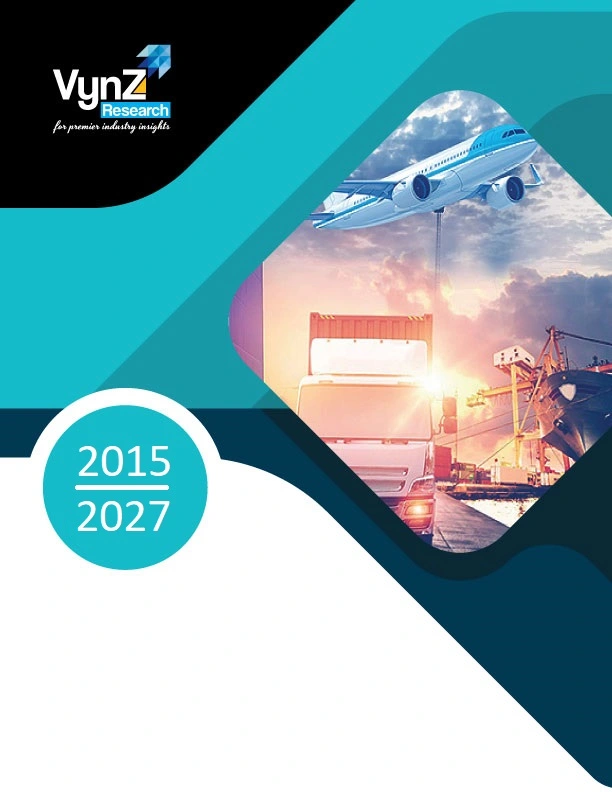Industry Overview
The Global Fuel Cell Electric Vehicle Market is expected to be USD 1.8 billion in 2023 and is projected to reach USD 14.5 billion by 2030, thus, anticipated to grow at a CAGR of 37.5% during the forecast period 2025-2030.

Fuel cell electric vehicles (FCEVs) are power-driven by hydrogen having a compact-size battery. Factors attributing to the growth of the fuel cell vehicle (FCEV) market include stringent norms for carbon emissions, mounting adoption of electric vehicles in developing economies, substantially longer driving ranges than battery electric vehicles (BEVs), the launch of low-cost hydrogen-powered electric passenger cars to attract consumers, and rising need for better fuel efficiency. Nevertheless, the upsurge in consumer awareness about healthy air quality and the harmful effects of vehicular emissions will fuel the growth of the fuel cell electric vehicle market globally.
The COVID-19 pandemic has hurt the global fuel cell electric vehicle (FCEV) market owing to the implementation of strict lockdowns globally, shut down of manufacturing facilities, and disruption in the supply chain. This has resulted in a decline in crude oil prices which went into the negatives. Thus, high prices of FCEVs and low prices of crude oil have discouraged people from purchasing FCEVs.
Fuel Cell Electric Vehicle (FCEV) Market Segmentation
Insight by Type
Based on type, the global fuel cell electric vehicle market is divided into Polymer Electrolyte Membrane Fuel Cells (PEMFC) and Phosphoric Acid Fuel Cell (PAFC). The PEMFC is the best option for automobile use and is anticipated to grow fast during the forecast period 2023-2030. It is a commonly used low-temperature fuel cell type to generate electricity from hydrogen and consists of a platinum catalyst that is ideal for vehicle use.
Insight by Range
Based on range, the global fuel cell electric vehicle market is bifurcated into short-range and long-range. Short-range is anticipated to witness the fastest growth during the forecast period owing to increasing demand for low-emission vehicles for short-distance travel. Furthermore, FCEV is being increasingly adopted in diverse applications i.e., transportation of goods within ports and airports and by e-commerce companies to decrease carbon footprint will have a positive effect on the fuel cell electric vehicle market.
Insight by Vehicle Type
Based on vehicle type, the global fuel cell electric vehicle (FCEV) market is divided into passenger vehicles and commercial vehicles. The passenger vehicle dominates the market owing to strict norms to stop vehicular pollution. Moreover, increasing per capita income in emerging economies and rising demand for clean personal mobility will fuel the growth in the fuel-cell electric vehicle market. For example, South Korea is anticipated to deploy 1,20,000 fuel cell vehicles by 2040.
Global Fuel Cell Electric Vehicle (FCEV) Market Report Coverage
|
Report Metric
|
Details
|
|
Historical Period
|
2018 - 2023
|
|
Base Year Considered
|
2024
|
|
Forecast Period
|
2025 - 2030
|
|
Market Size in 2024
|
U.S.D. 1.8 Billion
|
|
Revenue Forecast in 2030
|
U.S.D. 14.5 Billion
|
|
Growth Rate
|
37.5%
|
|
Segments Covered in the Report
|
By Type,By Range,By Vehicle Type
|
|
Report Scope
|
Market Trends, Drivers, and Restraints; Revenue Estimation and Forecast; Segmentation Analysis; Impact of COVID-19; Companies’ Strategic Developments; Market Share Analysis of Key Players; Company Profiling
|
|
Regions Covered in the Report
|
North America,Europe,Asia-Pacific (APAC),Rest of the World (RoW)
|
Industry Dynamics
Fuel Cell Electric Vehicle (FCEV) Industry Trends
Fuel cell electric vehicles have gained prominence owing to enhanced performance, short refueling time, longer range, superior power, and high torque. Moreover, catalyst development will enhance durability in catalyst layer design, thus continuous technological development is the key trend in the global fuel cell electric vehicle market.
Fuel Cell Electric Vehicle (FCEV) Market Growth Drivers
The strict emission norms, less noise mobility solutions, increasing adoption of zero-emission vehicles, rising concern for carbon dioxide emissions leading to reduced demand for conventional vehicles, and development in fuel cell technology will contribute to the growth of the global fuel cell electric vehicle market. Furthermore, portable batteries, reduced time for refueling, long reach distance, and initiatives by the government will fuel the growth in the FCEV market. Nevertheless, with strict emission regulations in North America, initiatives by the government in developing FCEV technologies in Europe, rising adoption of electric vehicles in the Asia Pacific, and rising preference for low-emission mobility solutions in Latin America, economic growth depends on the adoption of electric vehicles in the Middle East and Africa will bolster the growth of FCEV market.
Fuel Cell Electric Vehicle (FCEV) Market Challenges
Challenges faced by the FCEV market include high vehicle costs and a lack of hydrogen fueling infrastructure that will hamper the growth of the FCEV market. Moreover, the high capital investment and high-cost components in FCEVs will increase the risk of failure and increase maintenance and repair costs resulting in impeding the growth of the FCEV market.
Fuel Cell Electric Vehicle (FCEV) Market Opportunities
The increasing requirement for sustainable solutions leads to reduced dependence on imports for oil and reduces harmful emissions that pollute the environment are the opportunities that create growth in the FCEV market. The initiatives by the government like subsidies on the purchase of FCEVs owing to the adoption of electric cars and bikes and the launch of low-cost hydrogen-powered electric passenger cars will create opportunities for the FCEV market.
Fuel Cell Electric Vehicle (FCEV) Market Geographic Overview
Asia-Pacific is anticipated to be the fastest-growing region in the FCEV market owing to the stringent emission norms. Moreover, many countries are investing huge amounts in the advancement of hydrogen fuel cell vehicles. Toyota Motor Corporation and Hyundai Motor Company provide fuel-cell passenger cars, buses, and logistical vehicles in the region.
Fuel Cell Electric Vehicle (FCEV) Market Competitive Insight
The key strategies adopted by the manufacturers of FCEVs are partnerships and collaborations with other automobile original equipment manufacturers (OEMs) to strengthen their strong foothold in the global FCEV market.
Toyota Motor Corporation is a Japanese multinational automotive manufacturer headquartered in Toyota City, Aichi, Japan. Founded by Kiichiro Toyoda and incorporated on August 28, 1937, Toyota is the largest automobile manufacturer in the world, producing about 10 million vehicles per year.
Honda Motor Co., Ltd. is a Japanese public multinational conglomerate manufacturer of automobiles, motorcycles, and battery-powered equipment, headquartered in Minato, Tokyo, Japan. Honda has been the world's largest motorcycle manufacturer since 1959.
Recent Developments by Key Players
Continental Tire recently opened its Continental Retread Solutions Development Center in Rock Hill, S.C. with a focus on retread process improvements and technology development.
Toyota Kirloskar Motor (TKM) has announced the supply of its Fuel Cell Module to Ashok Leyland to build a fuel-cell commercial vehicle in India for the purpose of proto examination and feasibility study purpose. The company is strengthening its role as an FC system supplier
Nikola Corporation produced 42 and wholesaled 35 Class 8 Nikola hydrogen fuel cell electric vehicles (FCEVs) in 2023. Of the seven trucks produced but not wholesaled, three are being used in an extended field test with a fleet partner; two are in continued validation and engineering; and two are being used for service training.
Some of the key players operating in the fuel cell electric vehicle (FCEV) market: are TOYOTA MOTOR CORPORATION, Honda Motor Co., Ltd., Hyundai Motor Company, ASHOK LEYLAND, Nikola Corporation, Daimler AG, Solaris Bus & Coach sp. z.o.o., SAIC Motor Corporation Limited, Tata Motors, and Volkswagen AG.
The Fuel Cell Electric Vehicle (FCEV) Market report offers a comprehensive market segmentation analysis along with an estimation for the forecast period 2025–2030.
Segments Covered in the Report
- By Type
- Polymer Electrolyte Membrane Fuel Cell (PEMFC)
- Phosphoric Acid Fuel Cell (PAFC)
- By Range
- By Vehicle Type
- Passenger Vehicles
- Commercial Vehicles
Region Covered in the Report
- North America
- Europe
- Germany
- U.K.
- France
- Italy
- Spain
- Russia
- Rest of Europe
- Asia-Pacific (APAC)
- China
- Japan
- India
- South Korea
- Rest of Asia-Pacific
- Rest of the World (RoW)
- Brazil
- Saudi Arabia
- South Africa
- U.A.E.
- Other Countries
.png)
Source: VynZ Research




.png)